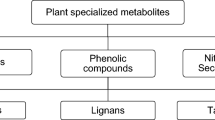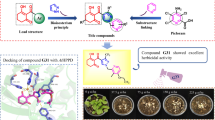Abstract
An additional reaction of the plant phenylpropanoid pathway is that catalyzed by coniferyl aldehyde dehydrogenase (HCALDH) to form cytosolic ferulic acid from coniferaldehyde. Because ferulic acid anchors lignin in cell wall polysaccharides and causes cell wall recalcitrance, the HCALDH inhibition could be a prominent target to release fermentable sugars from lignocellulose biomass and improve the saccharification efficiency. Here, we evaluated the role of the flavanone glycoside naringin (NRG), prospected in silico, as a selective inhibitor of the HCALDH of Zea mays (ZmaysHCALDH). A homotetrameric structural model in the absence of ligands was used for evaluations. The stability of the ZmaysHCALDH–NRG complex was checked via molecular dynamics simulation of the apo form (Apo–HCALDH) and that bonded to the inhibitor (NRG–HCALDH), both for the tetrameric form. The conformation bound to NRG varied less in relation to the apo form, and thus could be considered more stable. To obtain kinetic parameters, activities of a partially purified ZmaysHCALDH preparation were determined in vitro using high performance liquid chromatography. In comparison to the NRG-free control, Vmax and Km data suggested a kinetic profile of uncompetitive inhibition with respect to the substrate coniferyl aldehyde. In brief, this combinatorial in silico and in vitro approach suggest that NRG-induced inhibition of ZmaysHCALDH may be an attractive strategy to explore new clues regarding the phenylpropanoid pathway, the role of ferulic acid in the cell wall and, and mainly the digestibility of lignocellulosic biomass for biorefinery purposes.





Similar content being viewed by others
Abbreviations
- HCALDH:
-
Coniferyl aldehyde dehydrogenase
- DMSO:
-
Dimethyl sulfoxide
- DTT:
-
Dithiothreitol
- EDTA:
-
Ethylenediamine tetraacetic acid
- NRG:
-
Glycoside naringin
- ZmaysHCALDH:
-
HCALDH of Zea mays
- HPLC:
-
High performance liquid chromatography
- K i :
-
Inhibitor constant
- V max :
-
Maximal velocity
- K m :
-
Michaelis–Menten constant
- MD:
-
Molecular dynamics
- NAD+ :
-
Nicotinamide adenine dinucleotide
- rmsf:
-
Root mean square fluctuation
- rgyr :
-
Radius of gyration
- rmsd:
-
Root mean square deviation
References
Achterholt S, Priefert H, Steinbüchel A (1998) Purification and characterization of the coniferyl aldehyde dehydrogenase from Pseudomonas sp. strain HR199 and molecular characterization of the gene. J Bacteriol 180(17):4387–4391
Barros J, Serk H, Granlund I, Pesquet E (2015) The cell biology of lignification in higher plants. Ann Bot 115(7):1053–1074. https://doi.org/10.1093/aob/mcv046
Boerjan W, Ralph J, Baucher M (2003) Lignin biosynthesis. Annu Rev Plant Biol 54:519–546. https://doi.org/10.1146/annurev.arplant.54.031902.134938
Bonawitz ND, Chapple C (2013) Can genetic engineering of lignin deposition be accomplished without an unacceptable yield penalty? Curr Opin Biotechnol 24(2):336–343. https://doi.org/10.1016/j.copbio.2012.11.004
Bradford MM (1976) A rapid and sensitive method for the quantitation of microgram quantities of protein utilizing the principle of protein dye binding. Anal Biochem 72(1–2):248–254
Bueno PSA, Kato-Schwartz CG, de Souza Lima D, Bracht A, Peralta RM, Seixas FAV (2019) In silico evaluation of condensed and hydrolysable tannins as inhibitors of pancreatic α-amylase. J Mol Model 25(9):275. https://doi.org/10.1007/s00894-019-4176-3
Calvo-Flores FG, Dobado JA, Isac-García J, Martín-Martínez FJ (2015) Lignin and lignans as renewable raw materials. Chemistry, technology and applications. Wiley, Chichester
Dallakyan S, Olson AJ (2015) Small-molecule library screening by docking with PyRx. Methods Mol Biol 1263:243–250. https://doi.org/10.1007/978-1-4939-2269-7_19
Dong J, Wu F, Zhang G (2006) Influence of cadmium on antioxidant capacity and four microelement concentrations in tomato seedlings (Lycopersicon esculentum). Chemosphere 64(10):1659–1666. https://doi.org/10.1016/j.chemosphere.2006.01.030
Emsley P, Cowtan K (2004) Coot: model-building tools for molecular graphics. Acta Crystallogr Sect D Biol Crystallogr 60:2126–2132. https://doi.org/10.1107/S0907444904019158
Eudes A, Liang Y, Mitra P, Loqué D (2014) Lignin bioengineering. Curr Opin Biotechnol 26:189–198. https://doi.org/10.1016/j.copbio.2014.01.002
Ferro AP, Flores R Jr, Finger-Teixeira A, Parizotto AV, Bevilaqua JM, Oliveira DM, Molinari HBC, Marchiosi R, dos Santos WD, Seixas FAV, Ferrarese-Filho O (2020) Inhibition of Zea mays coniferyl aldehyde dehydrogenase by daidzin: a potential approach for the investigation of lignocellulose recalcitrance. Process Biochem 90:131–138. https://doi.org/10.1016/j.procbio.2019.11.024
Frisch MJ, Trucks GW, Schlegel HB et al (2009) Gaussian 09, revision A.01. Gaussian, Inc., Wallingford
Grabber JH, Ralph J, Lapierre C, Barrière Y (2004) Genetic and molecular basis of grass cell-wall degradability. I. Lignin–cell wall matrix interactions. Comp Rend Biol 327(5):455–465
Homem DP, Flores R Jr, Tosqui P, Rozada TC, Basso EA, Gasparotto A Jr, Seixas FAV (2013) Homology modeling of dihydrofolate reductase from T. gondii bonded to antagonists: molecular docking and molecular dynamics simulations. Mol Biosyst 9:1308–1315. https://doi.org/10.1039/c3mb25530a
Humphrey W, Dalke A, Schulten K (1996) VMD: visual molecular dynamics. J Mol Gr 14(1):33–38. https://doi.org/10.1016/0263-7855(96)00018-5
Irwin JJ, Sterling T, Mysinger MM, Bolstad ES, Coleman RG (2012) ZINC: a free tool to discover chemistry for biology. J Chem Inf Model 52(7):1757–1768. https://doi.org/10.1021/ci3001277
Kalluri UC, Yin H, Yang X, Davison H (2014) Systems and synthetic biology approaches to alter plant cell walls and reduce biomass recalcitrance. Plant Biotechnol J 12(9):1207–1216. https://doi.org/10.1111/pbi.12283
Keung WM, Klyosov AA, Vallee BL (1997) Daidzin inhibits mitochondrial aldehyde dehydrogenase and suppresses ethanol intake of Syrian golden hamsters. Proc Natl Acad Sci 94(5):1675–1679
Končitíková R, Vigouroux A, Kopečná M, Andree T, Bartos J, Sebela M, Morera S, Kopecny D (2015) Role and structural characterization of plant aldehyde dehydrogenases from family 2 and family 7. Biochem J 468(1):109–123
Liu C-J, Cai Y, Zhang X, Gou M, Yang H (2014) Tailoring lignin biosynthesis for efficient and sustainable biofuel production. Plant Biotechnol J 129(9):1154–1162. https://doi.org/10.1111/pbi.12250
Lowe ED, Gao GY, Johnson LN, Keung WM (2008) Structure of daidzin, a naturally occurring anti-alcohol-addiction agent, in complex with human mitochondrial aldehyde dehydrogenase. J Med Chem 51(15):4482–4487. https://doi.org/10.1021/jm800488j
Mackerell AD Jr, Feig M, Brooks CL (2004) Extending the treatment of backbone energetics in protein force fields: limitations of gas-phase quantum mechanics in reproducing protein conformational distributions in molecular dynamics simulations. J Comput Chem 25(11):1400–1415. https://doi.org/10.1002/jcc.20065
Marriot PE, Gómez LD, McQueen-Mason SJ (2016) Unlocking the potential of lignocellulosic biomass through plant science. New Phytol 209(4):1366–1381. https://doi.org/10.1111/nph.13684
Meents MJ, Watanabe Y, Samuels AL (2018) The cell biology of secondary cell wall biosynthesis. Ann Bot 121(6):1107–1125. https://doi.org/10.1093/aob/mcy005
Morris GM, Huey R, Lindstrom W, Sanner MF, Belew RK, Goodsell DS, Olson AJ (2009) AutoDock4 and AutoDockTools4: automated docking with selective receptor flexibility. J Comput Chem 30(16):2785–2791. https://doi.org/10.1002/jcc.21256
Mottiar Y, Vanholme R, Boerjan W, Ralph J, Mansfield SD (2016) Designer lignins: harnessing the plasticity of lignification. Curr Opin Biotechnol 37:190–200. https://doi.org/10.1016/j.copbio.2015.10.009
Nagar S, Argikar UA, Tweedie DJ (2014) Enzyme kinetics in drug metabolism. Fundamentals and applications. Humana Press, New York
Nair RB, Bastress KL, Ruegger MO, Denault JW, Chapple C (2004) The Arabidopsis REF1 gene encodes an aldehyde dehydrogenase involved in ferulic acid and sinapic acid biosynthesis. Plant Cell 16(2):544–554. https://doi.org/10.1105/tpc.017509
Oliveira DM, Finger-Teixeira A, Mota TR, Salvador VH, Moreira-Vilar FC, Mitchell RAC, Marchiosi R, Ferrarese-Filho O, dos Santos WD (2015) Ferulic acid: a key component in grass lignocellulose recalcitrance to hydrolysis. Plant Biotechnol J 13(9):1224–1232. https://doi.org/10.1111/pbi.12292
Phillips JC, Braun R, Wang W, Gumbart J, Tajkhorshid E, Villa E, Chipot C, Skeel RD, Kale L, Schulten K (2005) Scalable molecular dynamics with NAMD. J Comput Chem 26(16):1781–1802. https://doi.org/10.1002/jcc.20289
Ragauskas AJ, Beckham GT, Biddy MJ, Chandra R, Chen F, Davis MF, Davison BH, Dixon RA, Gilna P, Keller M, Langan P, Naskar AK, Sadler JN, Tschaplinski TJ, Wyman CE (2014) Lignin valorization: improving lignin processing in the biorefinery. Science. https://doi.org/10.1126/science.1246843
Souza WR, Martins PK, Freeman J, Pellny TK, Michaelson LV, Sampaio BL, Vinecky F, Ribeiro AP, da Cunha BADB, Kobayashi AK, de Oliveira PA, Campanha RB, Pacheco TF, Martarello DCI, Marchiosi R, Ferrarese-Filho O, dos Santos WD, Tramontina R, Squina FM, Centeno DC, Gaspar M, Braga MR, Tiné MAS, Ralph J, Mitchell RAC, Molinari HBC (2018) Suppression of a single BAHD gene in Setaria viridis causes large, stable decreases in cell wall feruloylation and increases biomass digestibility. New Phytol 218(1):81–93. https://doi.org/10.1111/nph.14970
Steinmetz CG, Xie P, Weiner H, Hurley TD (1997) Structure of mitochondrial aldehyde dehydrogenase: the genetic component of ethanol aversion. Structure 5(5):701–711
Umezawa T (2018) Lignin modification in planta for valorization. Phytochem Rev. https://doi.org/10.1007/s11101-017-9545-x
Van Acker R, Vanholme R, Storme V, Mortimer JC, Dupree P, Boerjan W (2013) Lignin biosynthesis perturbations affect secondary cell wall composition and saccharification yield in Arabidopsis thaliana. Biotechnol Biofuels 6(1):46. https://doi.org/10.1186/1754-6834-6-46
Vanholme R, Cesarino I, Rataj K, Xiao Y, Sundin L, Goeminne G, Kim H, Cross J, Morreel K, Araujo P, Welsh L, Haustraete J, Vanholme B, Simpson GG, Halpin C, Boerjan W (2013) Caffeoyl shikimate esterase (CSE) is an enzyme in the lignin biosynthetic pathway in Arabidopsis. Science 341(6150):1103–1106. https://doi.org/10.1126/science.1241602
Xiao Y, Poovaiah C, Coleman HD (2014) Expression of glycosyl hydrolases in lignocellulosic feedstock: an alternative for affordable cellulosic ethanol production. BioEnergy Res 9(4):1290–1304. https://doi.org/10.1007/s12155-016-9766-7
Zoete V, Cuendet MA, Grosdidier A, Michielin O (2011) SwissParam: a fast force field generation tool for small organic molecules. J Comput Chem 32(11):2359–2368. https://doi.org/10.1002/jcc.21816
Acknowledgements
This work was supported by The Brazilian Council for Scientific and Technological Development—CNPq (Grants no. 477075/2011-8) and Araucaria Foundation—Brazil (Grants no. 20133960, 40/2016 and 53/2019). A. P. Ferro was recipient of a CNPq fellowship. O. Ferrarese-Filho and R. Marchiosi are research fellows of CNPq. The authors also acknowledge the National Center for High Performance Processing (CENAPAD, Brazil) for providing computational facilities.
Author information
Authors and Affiliations
Corresponding author
Ethics declarations
Conflict of interest
The authors declare that they have no competing interests.
Additional information
Publisher's Note
Springer Nature remains neutral with regard to jurisdictional claims in published maps and institutional affiliations.
Rights and permissions
About this article
Cite this article
Ferro, A.P., Parizotto, A.V., dos Santos, W.D. et al. Naringin inhibits the Zea mays coniferyl aldehyde dehydrogenase: an in silico and in vitro approach. J. Plant Biochem. Biotechnol. 29, 484–493 (2020). https://doi.org/10.1007/s13562-020-00561-0
Received:
Accepted:
Published:
Issue Date:
DOI: https://doi.org/10.1007/s13562-020-00561-0




